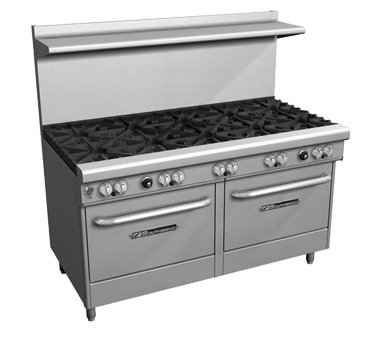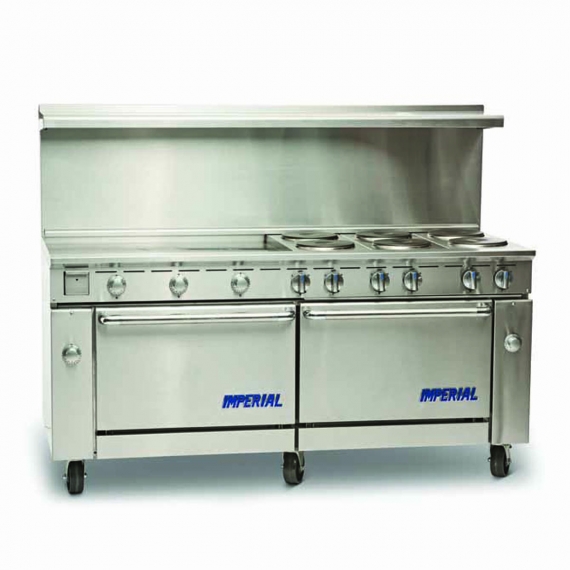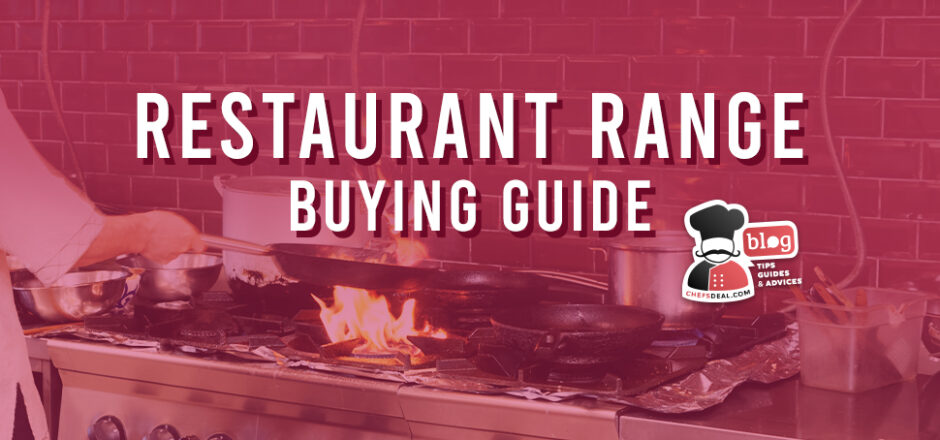A restaurant range is multifunctional cooking equipment featuring a top cooking surface and a base compartment. Both the surface and the base are customizable. The top configurations allow boiling, sauteing, grilling, frying, and more. Alternatives for the lower part are ovens of various styles and sizes, an open or enclosed storage cabinet, or a refrigerated base.
Commercial restaurant ranges are by far the most functional and flexible appliances. They’re also the hardest to choose with configuration, size, fuel type, and many other options. This comprehensive guide compiles almost everything you might need to compose the most optimal unit.
Restaurant Range Tops
Whether you purchase a countertop restaurant range or a freestanding model, it pays to give thoughtful consideration to the stovetop. Most cooking operations, including boiling, frying, grilling, or sauteing, happen on the top cooking area of your commercial stove. The suitable configuration matching your customer portfolio and recipes on the menu can save you precious space and bucks. You can combine up to three tops for maximum cooking flexibility and versatility.
1. Open Burners

Open burners are the most common cooking surface on restaurant ranges. You can safely place your pots, pans, or other cooking vessels on the cast-iron or stainless steel grates over these gas burners. The open flames instantly catch fire through standing pilots or electric ignition and provide the desired heat for boiling, frying, sauteing, or simmering ingredients. You can adjust temperatures separately for each burner through control knobs.
When browsing restaurant range tops, you might also encounter step-up open burners, meaning that the back burners are slightly above the front ones. This gives you easier access to cookware on the back burners. An open burner promises such versatile cooking that it’s the bread and butter of commercial stoves. Whether you need one is out of the question. Instead, it would help if you asked how many. Commercial restaurant gas ranges can have up to 12 open burners.
2. Commercial Griddles

Commercial griddles are already among the staples of today’s food service businesses. A griddle is a broad and flat cooking surface powered by gas or electric burners placed under a metal cooktop. The metal heats up and transfers its temperature to the items on it. Therefore, you can cook your menu items directly on it. A griddle top is ideal for grilling burgers or serving breakfast dishes like omelets, pancakes, and eggs.
The griddle plate is often cast-iron or stainless steel with a non-stick finish. You can quickly flip fish, steak, or other items to prevent burning. Various plate thicknesses and widths are available. Thicker plates heat up more slowly but provide better temperature retention. If you serve delicate items more frequently, a thinner surface would be preferable. Griddle widths vary between 12 and 60 inches, with increments at every 12 inches.
3. French Top

French top is a hot top with a large smooth cooking surface on a restaurant range. It has a griddle-like surface above a high-power burner, heating several circular rings with a flame only under the central ring. Therefore, the center of the plate is the hottest with reducing temperatures on the outer edges. That’s why French tops are also known as graduated hot tops. While the center provides the high heat necessary for cooking at high temperatures, the lower heat on the outer rings would be perfect for simmering or hot-holding tasks.
A restaurant range with a French top resembles a griddle. Only, you place food items directly on the griddle plate. However, a French top’s durable, smooth surface is for cooking in pots or pans. Also, you can move cookware on a French hot top without lifting them. This feature means a lot to chefs multitasking under time pressure. Temperature adjustment requires no heat control. All you need is to slide the cooking vessels around the concentric burners.
4. Plancha

“La plancha” in Spanish refers to searing food items on a hot metal plate. Plancha is the equipment used for this way of cooking. In that sense, it’s very similar to a griddle, but the heat source of a plancha offers more flexibility in grilling. Thus, it is becoming an increasingly viable restaurant range top option. A plancha top has a circular burner instead of side-to-side burners under a griddle plate. The heat radiates from the center as in French tops, making it the hottest part. The temperature gradually reduces towards the outer edges.
Why should you need a plancha on your restaurant range when you can grill your proteins or veggies on a griddle? Griddles can have multiple burners for even heat distribution across the cooking area, depending on the size. In fast-paced foodservice facilities, chefs always have to adjust the heat from each burner separately to prevent food burns. A plancha top removes this need. You can start cooking your dishes in the middle and move them to the outer sides. Plus, plancha cooking can impart a smokey taste.
5. Charbroiler

A charbroiler top works like a typical outdoor grill, cooking products over open flames. The grates above the burners create mouthwatering sear marks while the flames add a smoky and juicy texture. For a perfect BBQ flavor, burners generate extremely intense heat that can go up to 550 degrees or even more. The grates are cast-iron or stainless steel to ensure even heating and withstand high temperatures.
Depending on the size of your commercial stove, you can opt to have various charbroiler widths, which fall between 12 and 60 inches. This size often comes in increments at every 6 or 12 inches, with additional burners. Grilling can mess your restaurant range with grease drippings and food crumbs. Charbroilers have removable grease troughs for a hassle-free unit cleaning after every batch.
Base Configurations
If you’re in the market for a countertop model, you’re almost done with your purchase. Yet, most standard restaurant ranges will also have several base alternatives. Although not as many as top configuration options, you need to make a few more decisions to customize your range’s base. Variations here aim to help you get the best out of your available space, improve your workflow, and increase your cooking versatility.
1. Ovens

There are several oven alternatives to go with a restaurant range top. Standard ovens are the conventional models with two heating elements. The heat source at the bottom bakes the products while the top element broils them. This system may fail to distribute heat evenly inside the oven cavity. Convection ovens achieve uniform heat distribution by circulating the hot air throughout the baking chamber with built-in fans. The result is a perfectly browned, crispier crust.
Oven alternatives also vary by size. Standard bakery-depth ovens measure 26″ in width or more while they can accommodate full-size pans front-to-back or side-by-side. If you can’t spare a large footprint for a restaurant range, you can go for space-saver oven bases, which are mostly 20″ wide by 26″ deep. Therefore, they can hold full-size sheet pans only lengthwise, front-to-back.
Depending on what size commercial stove you need and what items you often bake, you can ask for two ovens. For instance, a conventional oven is okay for cakes that need to rise to a fluffy texture. It’d be wise to combine this with a convection oven to enrich your menu with roasted and toasted dishes. The same is possible with oven sizes, too. If you want a two-oven capacity in less horizontal space, you can arrange your restaurant range base with one standard-size and one space-saver oven.

2. Cabinet Base
It is common to see restaurant ranges with an oven base, but that isn’t the only option. A convection oven underneath a commercial stove would be a great addition. However, these can’t approach dedicated convection ovens in baking performance. Facilities primarily serving delectable pizzas, cookies, muffins, or roast meats in large batches will need separate ovens. They might find an oven base redundant. In that case, an open or enclosed cabinet under a restaurant range top can keep pans, pots, or cooking utensils within easy reach.
3. Refrigerated Base
The room under a restaurant range top can also serve as a cold storage area. Refrigerated bases have racks to hold perishables at safe temperatures. Keeping cold ingredients right under a cooktop gives you a more efficient cooking station. For example, quick access to cold-stored foods means fewer trips to your reach-in or walk-in refrigerators.

4. Open Base With Legs
You’re free to demand nothing underneath your restaurant range. Your establishment may be rich in ovens and storage cabinets. In that case, you can get a restaurant range with legs. These legs are made from heavy-duty stainless steel to hold the weight of the range top and cookware. Models with an undershelf attached to legs are also available.
Restaurant Range Types
Types of commercial restaurant ranges on the market are not as varied as the configuration alternatives. Commercial stoves are mainly classified by power source, size, and use.
1. Electric vs. Gas Ranges
Gas or electricity is a never-ending discussion in commercial cooking equipment. Because each fuel type has its own benefits, there isn’t really a correct answer. Yet, there are some established beliefs. Commercial electric stoves utilize resistance wires recessed under a smooth cooking surface. You don’t have to worry about the risks involved in open flames. Thus, your restaurant range will also produce less excess heat. Electric restaurant ranges are plug-and-use appliances so that you won’t spend extra bucks for installation.

If you desire to cook over direct flames, you need a restaurant range with open gas burners. All gas cooktops are known to preheat and cook faster. Plus, gas is more economical than electricity. Gas burners can generate incredibly high powers, specified as BTU ratings. The higher the BTU output, the higher the cooking power. Finer temperature adjustments are quicker with gas burners. Therefore, many pro chefs love the precise cooking control with gas stoves. It’s also great that you aren’t restricted to natural gas only. Conversion kits help you shift to propane, too.
Restaurant ranges are also available in dual-fuel cooking flexibility. Dual-fuel ranges benefit from the instant power of a gas cooktop and the precise baking of an electric oven. You can thus combine the benefits of gas and electricity.
2. Heavy-Duty Commercial Ranges vs. Restaurant Ranges

Heavy-duty ranges boast more robust construction. They are built from metals with much thicker gauges to stand the test of time and heavier use in high-volume operations. They generally measure 32 or 36 inches, but they can turn into an island-style cooking station. They’re also known as modular ranges as they can be banked into multi-range configurations. You can specify the gas connection point so you can connect more equipment. Their burners generate more powerful energy, amounting to 45,000 BTUs. All these unique features make them pricier, of course.
Not all facilities need the high output that heavy-duty models promise. Restaurant ranges are a more economical option for such businesses. They’re robust and powerful enough to serve large crowds in many busy establishments. They’re available in sizes varying from 24″ to 72″. Burner numbers will increase in tandem with the size. For instance, 48, 60, and 72-inch ranges will typically have 8, 10, and 12 burners, respectively. The most preferred sizes are 24″, 48″, and 60″. BTU ratings can go up to 32,000 or even 35,000, which is more than enough for many cooking tasks.

3. Specialty Restaurant Ranges
Cooking vessels used in restaurant ranges vary in size and shape. High-volume establishments wish to deliver soups, sauces, or other liquid dishes in bulky stockpots. Working with this cookware on standard ranges can be risky. The low-height design and large burner sections of stockpot ranges ensure easier handling of heavy pots. Manufacturers develop models catering to increasing wok-cooking demands, too. Wok ranges feature holes and raised rings to accommodate the round-bottomed woks, and their burners produce high BTU ratings required for stir-fried recipes with Chinese woks.
Additional Installation Tips And Accessories For Restaurant Ranges
The versatility of restaurant ranges can take your menus to the next level, driving up profitability. Paying attention to the details below can create differences in operational results.
- Range Hood: Codes require hoods to extend 6 inches beyond the restaurant range footprint. For example, a 48-inch range must be installed under a 54-inch hood.
- Gas Hoses: Again, safety codes dictate using flexible hoses for installing gas equipment. You’ll often have to move your range for cleaning, so flexible connectors can be critical.

- Casters: Equipment mobility rests on practical and mandatory reasons. Kitchen reconfiguration always gives a fresh taste to your general outlook. Casters will enable you to roll your restaurant range to anywhere in your kitchen. Also, inspectors will want to check whether all equipment parts are accessible.
- Ignition: Standard pilot is the traditional ignition source in commercial gas ranges. It is less efficient than electronic ignition because it consumes some gas to keep the gas valve open. Electronic ignition removes this need.

- Add-Ons: You can continue making your restaurant range more functional by adding accessories. A flue riser can be one. Flue risers are the protective metals attached to the back of commercial ranges. Some have one or two shelves to store your spices or cooking utensils. These backguards can have holes for mounting extra appliances, like a cheese melter or salamander broiler, often not included in range top configuration options.
Final Thoughts on Restaurant Range Configuration
When browsing restaurant ranges, you encounter a host of features and specifications. They are perhaps the most customizable commercial cooking equipment in the industry. Your final evaluation should be based on how to maximize the efficiency to serve the best for your customers. Here are a few more practical ideas to help you with your decision.
1. Open Burners vs. Flat Tops

A recurring discussion about restaurant range configurations is whether open flames or flat tops are better. Many professional chefs have long fallen for the visible flames from open gas burners. They’re unmatched in terms of power, heat distribution, and versatility. High heat is the top priority for pro chefs to boil liquids or prepare sauces instantly. Open burners also provide more uniform cooking. The powerful flames from open gas burners spread to the whole cookware, licking up all its sides. Thus, ingredients receive equal heat wherever they’re in your pot or pan.
A well-known strength of flat tops is their ease of cleaning. You simply wipe down anything on a plancha, griddle, or French top. Your cooking surface will always look spotless with minimum effort. This is not the case for charbroilers and open burners because spills leaking down the burner area may cause a severe hassle. Plus, flat tops, particularly the modern ceramic glass surfaces, sparkle with their sleek and stylish appearance.
You can have the advantages of two worlds with a combined surface on your restaurant range. Flat cooking surfaces are designed for specific cooking tasks. French tops are experts in simmering, whereas planchas and griddles deliver unparalleled results in searing and caramelization through contact cooking. However, an open burner is suitable for practically every cooking method. You can also use it for wok cooking when you remove the top grate.
2. What Is The Best Restaurant Range Configuration?

It’s hard to answer this question as there’s not a one-fit-for-all type of cooking equipment. Your restaurant style, cook volumes, variety of menu items, and space limitations will specify the best configuration for you. The greatest thing about restaurant ranges is that you’re not limited to one type. You can customize the most efficient combination surface matching your needs and customer profiles. Here’s a possible best for a medium-size restaurant appealing not just to a single palate.
Most chefs rejoice in creating a culinary theater during pan-frying or sauteing over visible flames. Because you will also have to prepare different sauces instantly, a restaurant range with open burners is ground zero. Open burners can be your virtuoso in the kitchen but can’t satisfy BBQ addicts. A charbroiler would win you the favor of diners craving char-grilled steaks, poultry, or fish. Finally, you can complete your range top with a griddle to streamline and diversify the breakfast line. Then, a griddle top would do justice to your customers.
A facility addressing different appetites is also likely to get roast turkey orders. You may wish to mesmerize guests with your signature pastries. This will also create a bakery-like ambiance. Then, an oven base is inevitable. With two convection ovens on the base, you can deliver delectable dishes for every meal. In this case, your best is a commercial range with open burners, a charbroiler, and a griddle top configured on two convection ovens. It would be best if you found the best tuned to your needs because options are so many to compose your restaurant range.






